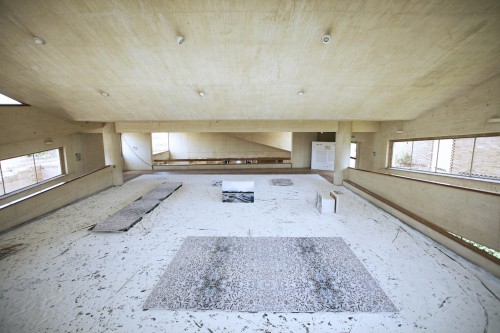
ANTICIPACIÓN / RETROVISIÓN III
El paisaje se encuentra en un estado de constante movimiento,
se construye a través de los rastros del pasado y de la
planificación del futuro. Muda su apariencia conforme al tiempo
y el espacio. Su superficie geográfica no es estática sino
evolutiva y está constituida por seres que emulan su actividad.
Revisar la trascendencia del hombre en un paisaje dinámico
es la consigna del artista colombiano Soler en Anticipación/
Retrovisión, obra que se expone en la Biblioteca Virgilio Barco
en el marco de FOTOGRÁFICA BOGOTA 2013.
Anticipación/Retrovisión nació gracias a la invitación que
recibió Soler por parte de la Universidad del Magdalena para
llevar a cabo una residencia artística en el año 2012 como
parte de la celebración de los 50 años de la institución. El
resultado fue un performance con la participación de la comunidad
universitaria, donde el artista congregó a más de 1000
asistentes, los cuales yacieron en el suelo de la universidad
para ser cubiertos con polvos blancos. Cuando los cuerpos se
levantaron dejaron tras de sí las huellas de su paso, dibujando
su silueta en la superficie. La acción recrea el devenir del
hombre, su presencia efímera y su conexión tanto física como
espiritual con la naturaleza. Cada elemento que intercede en
la obra tiene una carga simbólica; el polvo relacionado con el
cosmos, la tierra con la naturaleza, y el cuerpo como mediador
entre la tierra y el universo.
Las fotografías del performance guardan un parecido formal
con las imágenes rupestres de Altamira y Lascaux, pero
es en su valor simbólico donde reside su mayor conexión. Los
hombres del paleolítico pintaban los animales en las cavernas
siguiendo un ritual mágico donde el hombre buscaba poseer
la imagen del animal antes de cazarlo y como consecuencia
de este acto, la imagen se anteponía a la acción. De una manera similar, la obra de Soler no captura la
muerte sino que anticipa su imagen. El performance se
convierte en un ritual colectivo, y la cámara fotográfica se
transforma en un instrumento de la videncia.
La anticipación de la muerte se ve reflejada en el vacío
que deja el cuerpo sobre el paisaje. Los participantes del performance
dejan parte de sí en la tierra y se levantan con una
nueva mirada para confrontar su propia ausencia. La acción
invita al espectador a reflexionar sobre la existencia del hombre
y su presencia en el paisaje. Las fotografías de Soler son
tanto una evocación del pasado como una premonición del
futuro, estableciendo una relación entre el microcosmos del
hombre y el macrocosmos en el que habita.
The landscape is in a constant state of movement, is constructed
through the traces of the past and planning for the
future. Changes its appearance according to time and space.
Its geographical surface is not static but evolving and consists
of beings that emulate its activity. In his work Anticipación/
Retrovisión, Colombian artist Soler’s slogan is to review
on man’s importance in a dynamic landscape. This series is
shown in the Virgilio Barco Library under FOTOGRÁFICA
BOGOTA 2013.’s framework.
Anticipación/Retrovisión came out thanks to Soler being
invited by Magdalena University to undertake an artist residency
in the year 2012 as part of the celebration of the
institution’s 50th anniversary. The result was a performance
with the participation of the university community, in which
the artist brought together more than 1000 attendees; they
lay on the university’s floor to be covered with white powder.
When bodies rose they left behind traces of their passage,
drawing their silhouettes on the surface. The action recreates
man’s evolution, his ephemeral presence and his both physical
and spiritual connection with nature. Each element interceding
in his work has a symbolic load; dust associated with the
cosmos, the earth with nature, and the body as a mediator
between the earth and the universe.
The photographs of the performance bear a formal resemblance
to the rock paintings of Altamira and Lascaux, but is in
its symbolic value where lays its greater connection. Paleolithic
men painted animals inside the caves following a magical
ritual where men sought to have the animal’s image before
the hunt and as a result of this act; the image came before the
action. In a similar way, Soler’s does not capture
death but anticipates its image. The performance becomes a collective ritual, and the camera becomes an instrument of
clairvoyance.
Death’s anticipation is seen reflected in the gap left by the
body on the landscape. Performance participants leave part of
themselves in the land and rise with a new look to confront
their own absence. The action invites the viewer to reflect on
human existence and his presence in the landscape. Soler’s
photographs are both an evocation of the past and a premonition
of the future, establishing a relationship between man’s
microcosm and the macrocosm in which he lives.
DANIEL MARTÍNEZ MOLKES
Museógrafo